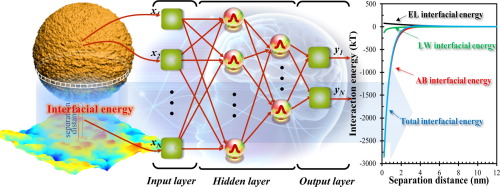当前位置:
X-MOL 学术
›
J. Colloid Interface Sci.
›
论文详情
Our official English website, www.x-mol.net, welcomes your
feedback! (Note: you will need to create a separate account there.)
Quantification of interfacial energies associated with membrane fouling in a membrane bioreactor by using BP and GRNN artificial neural networks.
Journal of Colloid and Interface Science ( IF 9.4 ) Pub Date : 2020-01-07 , DOI: 10.1016/j.jcis.2020.01.003 Yifeng Chen 1 , Liguo Shen 1 , Renjie Li 1 , Xianchao Xu 1 , Huachang Hong 1 , Hongjun Lin 1 , Jianrong Chen 1
Journal of Colloid and Interface Science ( IF 9.4 ) Pub Date : 2020-01-07 , DOI: 10.1016/j.jcis.2020.01.003 Yifeng Chen 1 , Liguo Shen 1 , Renjie Li 1 , Xianchao Xu 1 , Huachang Hong 1 , Hongjun Lin 1 , Jianrong Chen 1
Affiliation

|
Interfacial energy between sludge foulants and rough membrane surface critically determines adhesive fouling in membrane bioreactors (MBRs). As a current available method, the advanced extensive Derjaguin-Landau-Verwey-Overbeek (XDLVO) approach cannot efficiently quantify the interfacial energy. In this study, novel methods including back propagation (BP) artificial neural network (ANN) and generalized regression neural network (GRNN) were proposed to quantify the interfacial energy associated with the membrane fouling in an MBR. Different levels of 5 apparent input factors and the resulted interfacial energies were used as training and testing databases for establishment of ANN models. The established BP ANN and GRNN models exhibited high regression coefficients and accuracies, suggesting the high capacity of ANN models to capture the complicated non-linear mapping relations between interfacial energy and various factors. As compared with the advanced XDLVO approach, both BP ANN and GRNN showed remarkably improved quantification efficiency. Meanwhile, BP ANN showed better prediction performance than GRNN model. Case study further demonstrated the robustness and feasibility of BP ANN for interfacial energy quantification. This study provided a new approach to quantify interfacial energy associated with membrane fouling.
中文翻译:

通过使用BP和GRNN人工神经网络量化与膜生物反应器中膜污染相关的界面能。
污泥污垢和粗糙的膜表面之间的界面能决定膜生物反应器(MBR)中的粘合剂结垢。作为当前可用的方法,先进的扩展Derjaguin-Landau-Verwey-Overbeek(XDLVO)方法无法有效地量化界面能。在这项研究中,提出了包括反向传播(BP)人工神经网络(ANN)和广义回归神经网络(GRNN)在内的新方法,以量化与MBR中膜污染相关的界面能。5种不同的表观输入因子及其产生的界面能的不同水平被用作建立ANN模型的训练和测试数据库。建立的BP ANN和GRNN模型具有较高的回归系数和准确性,这表明ANN模型具有捕获界面能与各种因素之间复杂的非线性映射关系的高能力。与高级XDLVO方法相比,BP ANN和GRNN均显示出显着提高的量化效率。同时,BP ANN的预测性能优于GRNN模型。案例研究进一步证明了BP神经网络用于界面能量定量分析的鲁棒性和可行性。这项研究提供了一种新的方法来量化与膜污染相关的界面能。案例研究进一步证明了BP神经网络用于界面能量定量分析的鲁棒性和可行性。这项研究提供了一种新的方法来量化与膜污染相关的界面能。案例研究进一步证明了BP神经网络用于界面能量定量分析的鲁棒性和可行性。这项研究提供了一种新的方法来量化与膜污染相关的界面能。
更新日期:2020-01-07
中文翻译:

通过使用BP和GRNN人工神经网络量化与膜生物反应器中膜污染相关的界面能。
污泥污垢和粗糙的膜表面之间的界面能决定膜生物反应器(MBR)中的粘合剂结垢。作为当前可用的方法,先进的扩展Derjaguin-Landau-Verwey-Overbeek(XDLVO)方法无法有效地量化界面能。在这项研究中,提出了包括反向传播(BP)人工神经网络(ANN)和广义回归神经网络(GRNN)在内的新方法,以量化与MBR中膜污染相关的界面能。5种不同的表观输入因子及其产生的界面能的不同水平被用作建立ANN模型的训练和测试数据库。建立的BP ANN和GRNN模型具有较高的回归系数和准确性,这表明ANN模型具有捕获界面能与各种因素之间复杂的非线性映射关系的高能力。与高级XDLVO方法相比,BP ANN和GRNN均显示出显着提高的量化效率。同时,BP ANN的预测性能优于GRNN模型。案例研究进一步证明了BP神经网络用于界面能量定量分析的鲁棒性和可行性。这项研究提供了一种新的方法来量化与膜污染相关的界面能。案例研究进一步证明了BP神经网络用于界面能量定量分析的鲁棒性和可行性。这项研究提供了一种新的方法来量化与膜污染相关的界面能。案例研究进一步证明了BP神经网络用于界面能量定量分析的鲁棒性和可行性。这项研究提供了一种新的方法来量化与膜污染相关的界面能。











































 京公网安备 11010802027423号
京公网安备 11010802027423号